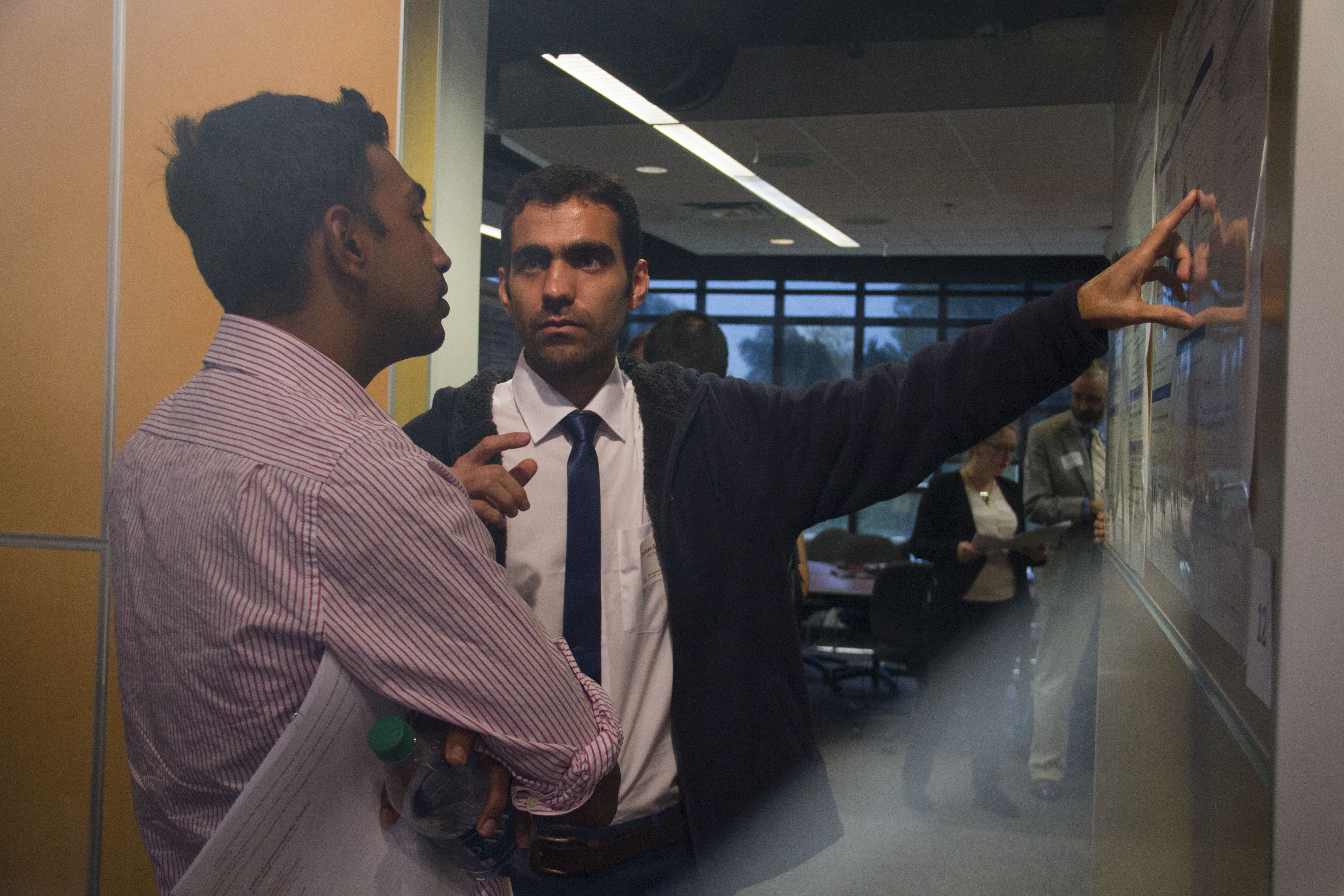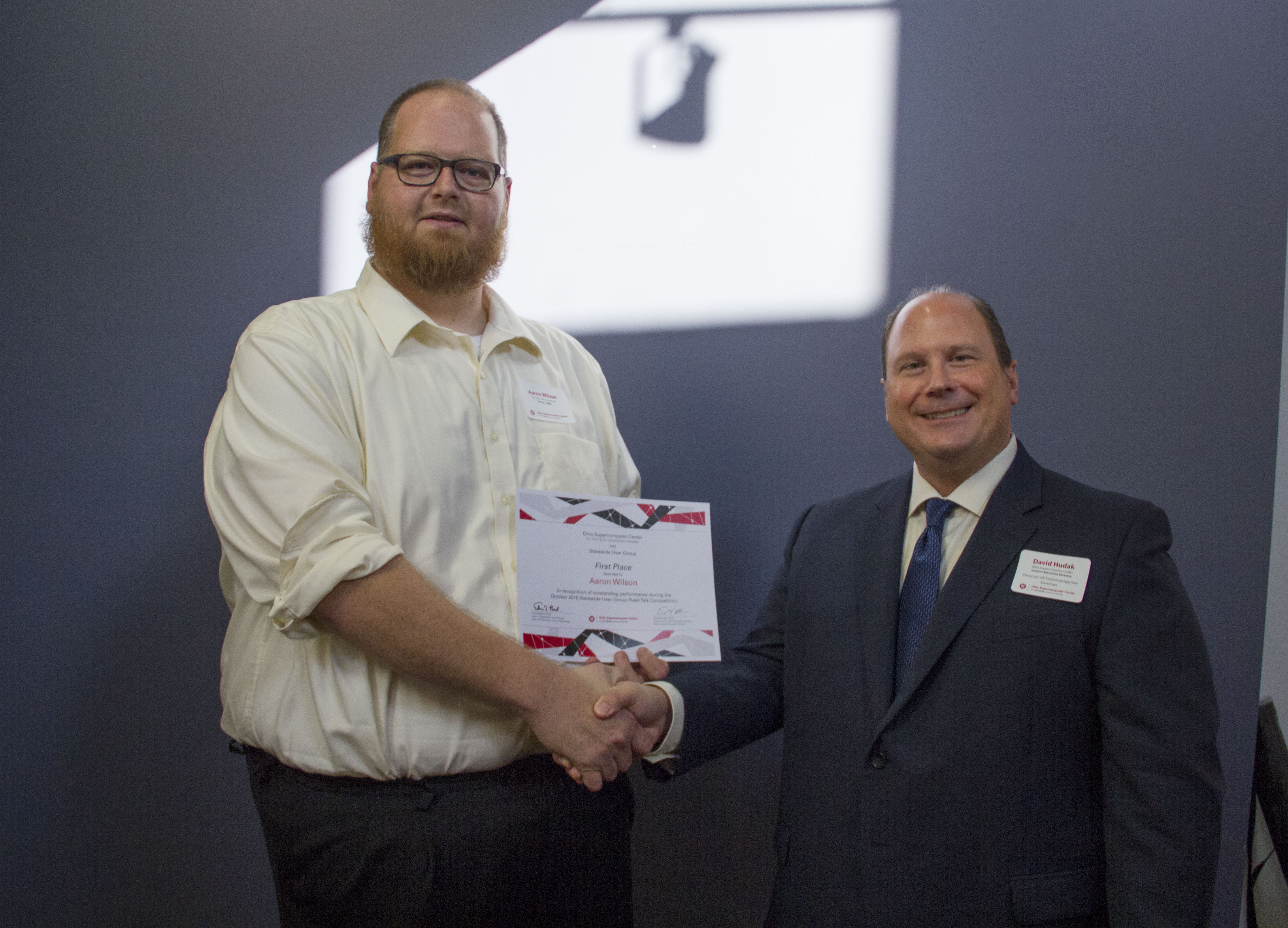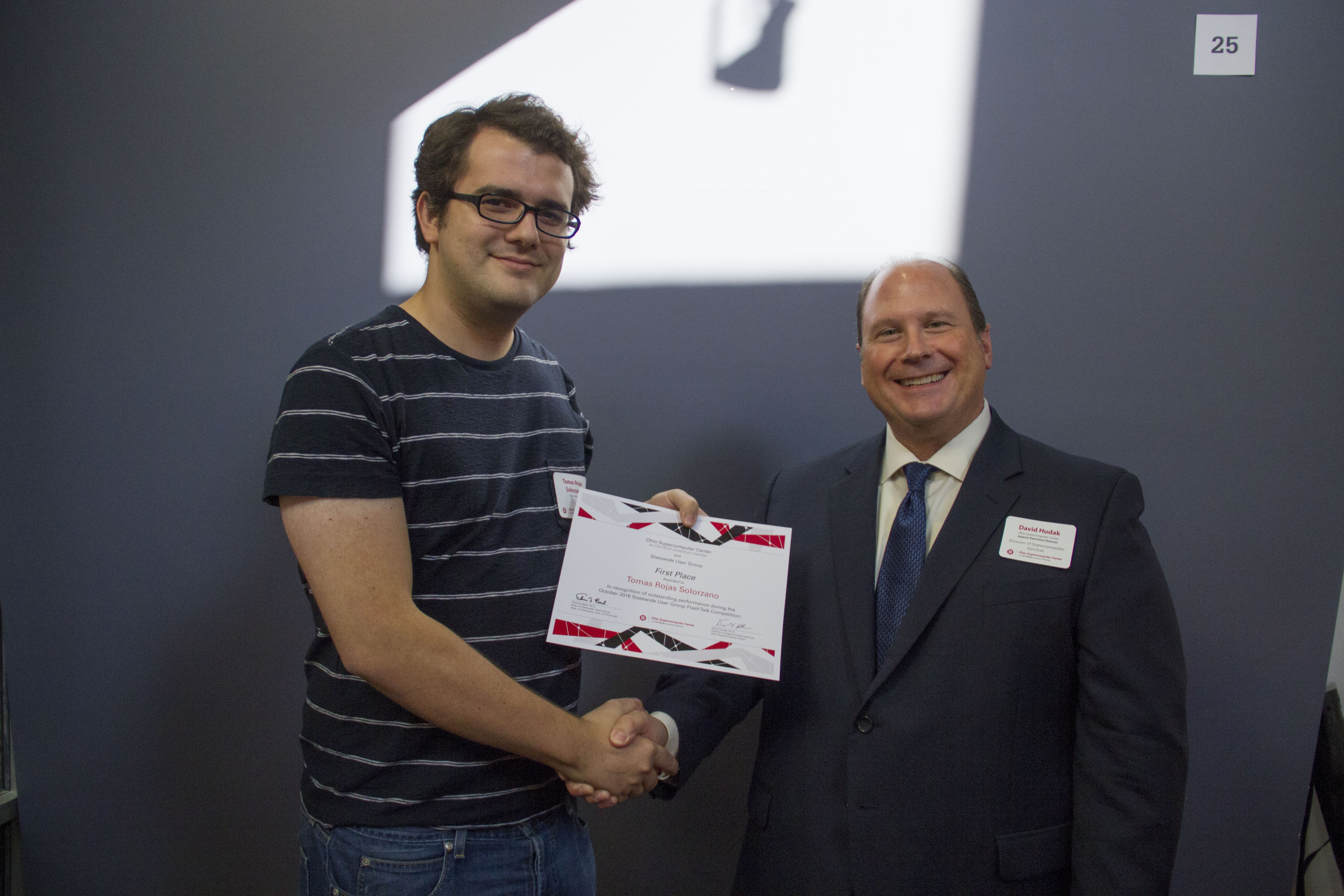Columbus, Ohio – More than ever, academic and manufacturing researchers from across Ohio are turning to the high performance computing power offered by the Ohio Supercomputer Center (OSC). On Thursday, an abundance of that research was on display at OSC’s semi-annual Statewide Users Group (SUG) meeting.

Attendees shared and gained insight into topics ranging from auto safety and dark matter to gene flow and a myriad of chemistry-related topics. They also heard two keynote addresses, and the competition portion of the meeting featured 27 posters and 12 flash talks.
OSC staff delivered presentations on its soon-to-be-deployed Owens Cluster, which will be the most powerful supercomputer in the history of the center, and the recently launched OnDemand3 web portal, a vastly upgraded version of OSC’s one-stop shop for access to high performance computing services.
SUG is a volunteer group composed of the scientists and engineers who provide OSC’s executive director with program and policy advice and direction to ensure a productive environment for research. SUG was instituted in 1986, a year prior to the creation of OSC, to advise administrators and policy makers on their planning and acquisition activities for the Center. Thursday’s SUG meeting was the fourth one in a row to feature the poster and flash talk competitions.
“We’ve continued to see growth every year since we switched to this format, and we’re really excited about that,” said Brian Guilfoos, HPC client services manager at OSC. “There are a lot of people coming here to show their work, and there’s a lot of enthusiasm for that. The ability to be able see what our users are doing with the services is great because that really is the most important part of what we do.”
The keynote addresses featured OSC users from both the industrial and academic worlds. Duane Detwiler, chief engineer of vehicle research and manager of the strategic research department at Honda R&D Americas Inc., presented on computer-aided engineering for lightweight vehicle development. His address was followed by Alexey T. Zayak, Ph.D., an assistant professor of physics and astronomy at Bowling Green State University, who spoke about the computational angle of vibrational spectroscopy of heterogeneous chemical interfaces.

After the keynote addresses, four winners were crowned for their flash talks and poster submissions. Winners claimed 5,000 resource units of time on OSC systems.
Ohio State’s Stephanie Kim and Sean Marguet tied for first place in the poster competition, while Ohio University’s Tomas Rojas won the chemistry flash talk competition and Aaron Wilson, from Ohio State, won the non-chemistry portion of the flash talks.
Kim’s poster was titled “Novel Binding Site of Cyclin A2 and Potential Inhibitors.” Marguet’s poster was titled “Computationally Guided Resonance Raman Spectroscopy of Nickel-Substituted Rubredoxin, A Model Hydrogenase Enzyme.”
In the flash talk competition, Wilson won for the second-straight meeting. His flash talk discussed “Pushing the Next-Generation Arctic System Reanalysis to the Human Scale,” while Solorazano’s

chemistry flash talk was on “Strain Fields and Electronic Structure of CrN.”
The next SUG meeting is scheduled for early April.
Flash Talks Participants:
- Abdulrhman Alsharari, Ohio University, “Proximity Effects of Dichalcogenide Monolayers on Graphene”
- Phwey (Dan) Gil, Case Western Reserve University, Surfactant Effectiveness in Ethanol-Water Mixtures
- Madushanka Manathunga, Bowling Green State University, Probing the Photodynamics of Rhodopsins with Reduced Retinal Chromophores
- Tomas Rojas Solorzano, Ohio University, Strain Fields and Electronic Structure of CrN

- Janani Sampath, The Ohio State University, Effect of Unneutralized Carboxyl Groups on the Behavior of Ionomers from Coarse Grained Molecular Dynamics Simulations
- Sichun Yang, Case Western Reserve University, iSPOT: A Multi-Technique Platform for Structural Modeling of Protein-Protein Complexes
- Oscar Avalos Ovando, Ohio University, Magnetic Interactions in Novel Two-Dimensional Materials
- Jitong Chen, The Ohio State University, Long Short-Term Memory for Speaker Generalization in Supervised Speech Separation
- Stacy Kim, The Ohio State University, In the Wake of Dark Giants: New Signatures of Dark Matter Self Interactions in Equal Mass Mergers of Galaxy Clusters
- Ariadna Morales, The Ohio State University, Speciation with Gene Flow in North American Myotis Bats
- Sultana Nahar, The Ohio State University, The Solar Opacity: Large Enhancements in Photoionization and Bound-Free Opacity

- Aaron Wilson, The Ohio State University, Pushing the Next-Generation Arctic System Reanalysis to the Human Scale
Posters:
- Miranda Caudle, Miami University, A Molecular Study of the Use of Ionic Liquids to Extract the Wastewater Contaminant Atenolol
- Sumudu Leelananda, The Ohio State University, Density Guided MD-Rosetta Protocol for Protein Structure Refinement
- Sergei Solonenko, The Ohio State University, Historical Demography of a Community of Marine Phages Reveals “Killing the Winner” in Action
- Dawei Zhai, Ohio University, Valley Polarization in Graphene with Out-of-Plane Deformation
- Esko Kautto, The Ohio State University, Optimizing Genomic Sequencing and Analysis to Detect Microsatellite Instability in Cancer
- Xuchun Yang, Bowling Green State University, Computational Study on Photodynamics of Rhodopsins with Reduced Retinal Chromophores
- Stephanie Kim, The Ohio State University, Novel Binding Site of Cyclin A2 and Potential Inhibitors
- Sultana Nahar, The Ohio State University, Electron-ion Recombination and Photoionization of P II
- Rabeta Yeasmin, Tennessee Technical University, Study the Interaction of Human Beta Defensin Type 3 with Lipid Membrane
- Joshua Berry, Tennessee Technical University, Study of Polymer Modified Asphalts Using Molecular Dynamics Simulations
- Garrett Long, Miami University, The Effect of Force Field Selection on Modeling Binary Aqueous Mixtures
- Mohsen Ghasemi, Ohio University, Evaporation of Water in Hydrophobic Confinement
- Tessa Eskander, Tennessee Technical University, Shear Viscosity Prediction of Pure Molecules Using Molecular Dynamic Method
- You Rao, The Ohio State University, A First-Principles Study of Defects in Ni-Based Alloys
- Patrick Gemperline, Xavier University, Modeling Crystal Structure Using Magnetic Ising Model
- Daniel Buey, The Ohio State University, Modeling the Effects of Yttrium Solutes on <c+a> Dislocations in Mg
- Zohre Gorunmez, University of Cincinnati Finite-Difference Time-Domain (FDTD) Modeling of Liposome-Based Substrates for Surface-Enhanced Raman Spectroscopy (SERS)
- Mohammad Shahriar, The Ohio State University, Slip-Stimulated Twinning Across Grain Boundaries in Titanium
- Dorothy Pharis, Cleveland State University, Which Clouds are Important: Variation of Cloud Size Distribution Functions in Large Eddy Simulations
- Kuan-Hsuan Shen, The Ohio State University, Determination of Domain Spacing in Double Gyroid Phase of Pure Diblock Copolymers
- Yaxian Wang, The Ohio State University, Ab Initio Study on Point Defects in Cubic Boron Arsenide (BAs)
- Travis Withrow, The Ohio State University, An Ab Initio Method for Improving Atom Probe Tomography Simulations
- Amy Connolly, The Ohio State University, Developing Novel Techniques for Searching for Ultra-High Energy Neutrinos in Antarctic Ice at OSC
- Robert White, Cleveland State University, On the Distribution of Humidity in the Convective Atmospheric Boundary Layer
- Sean Marguet, The Ohio State University, Computationally Guided Resonance Raman Spectroscopy of Nickel-Substituted Rubredoxin, A Model Hydrogenase Enzyme
- Andrew Paluch, Miami University, Combining MOSCED with Electronic Structure Calculations to Develop an Efficient Tool for Solvent Formulation and Selection
- Yu Zhang, The Ohio State University, Improved Atmospheric De-Aliasing Product for Satellite Gravimetry
The Ohio Supercomputer Center (OSC), a member of the Ohio Technology Consortium of the Ohio Board of Regents, addresses the rising computational demands of academic and industrial research communities by providing a robust shared infrastructure and proven expertise in advanced modeling, simulation and analysis. OSC empowers scientists with the vital resources essential to make extraordinary discoveries and innovations, partners with businesses and industry to leverage computational science as a competitive force in the global knowledge economy, and leads efforts to equip the workforce with the key technology skills required to secure 21st century jobs. For more, visit www.osc.edu.